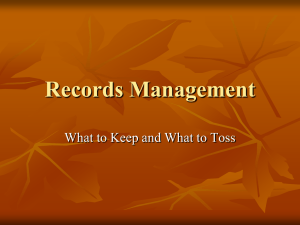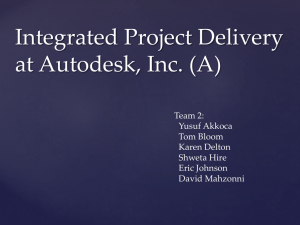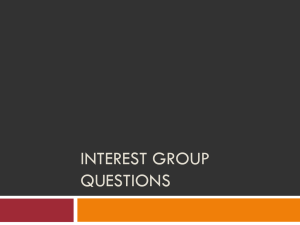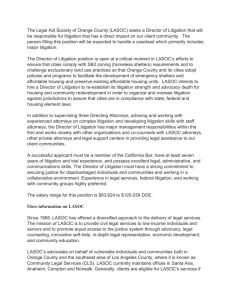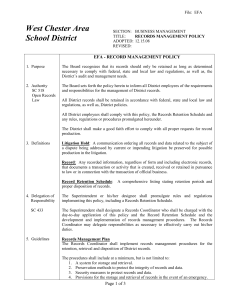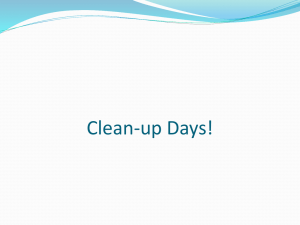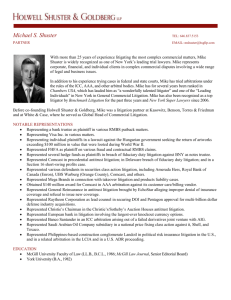Litigation Readiness – Information Managers Role
advertisement
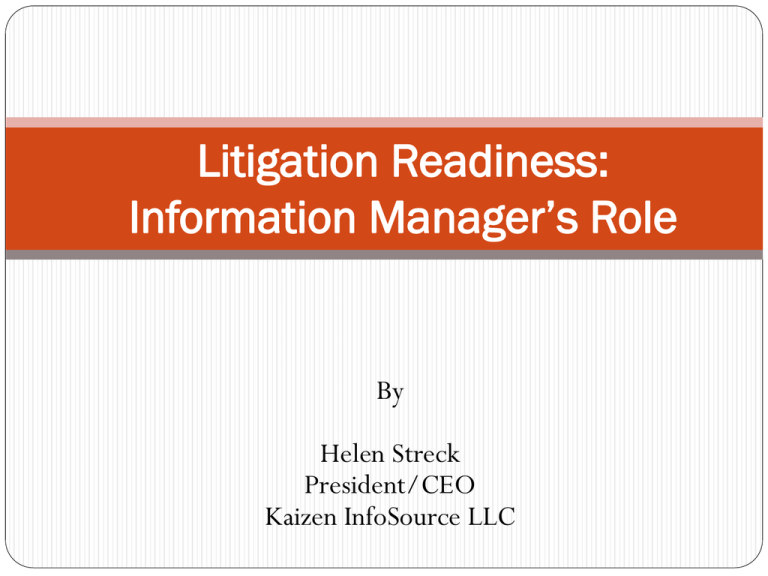
Litigation Readiness: Information Manager’s Role By Helen Streck President/CEO Kaizen InfoSource LLC Session Agenda IM Impacts on Litigation and eDiscovery Relationship of IM and Litigation Role of Information Manager Summary IM Impacts on Litigation and eDiscovery Information Management Impacts 93% of all records are created electronically & data growth Decrease in information findability/accessibility* 75% of all corporate information are duplicates Increase in the number of lawsuits filed in US Increase in the frequency of mergers/acquisitions and divestitures/business closure More systems – lack of collaboration *minimal improvement in last 2 years Data Growth Challenges Increase in repository redundancy Data Growth Challenges Multiple versions of same document Ver. 3 Increase in repository redundancy 2 1 Data Growth Challenges Deteriorating media Multiple versions of same document Increase in repository redundancy Data Growth Challenges System / application obsolescence Deteriorating media Multiple versions of same document Increase in repository redundancy Data Growth Challenges Increase in Orphaned data System / application obsolescence Deteriorating media Multiple versions of same document Increase in repository redundancy home Consequences are Clear Issue Consequence 1. Increase in redundancy 1. Increased costs with backups 2. Increase in system silos 2. Increase in operating costs 3. Improper decommissioning of systems 3. Increase in operating time 4. Poor classification of data 4. Increase in cost & time of Discovery 5. Increase risks Relationship of IM and Litigation IM Issues in Discovery and Litigation Governance – do you have a policy, retention schedule, procedures, and data map, implementation tools, guides Content and Process – what did you say (procedures) Findability and Accessibility – do you have a classification/taxonomy Normal Business Process - repeatable Training – how do employees know IM Governance & Controls That Help • Implemented Retention Schedules • Procedures and controls for archiving, decommissioning systems and removing inactive data • Legal Holds target relevant data and suspend normal disposition • Capturing data from exiting employees • Training & Communication keep employees informed & aware Good IM is Being Litigation Ready Eliminates obsolete information Ensures information ownership – avoiding abandoned data sets Minimizes duplicates and versions Communicates Litigation Hold requirements Provides a mechanism for preserving information from departing employees Promotes employee awareness What’s the Bottom Line! Processes and controls that manage records and information throughout its lifecycle, aid in finding the relevant information in the most cost effective manner and assuring its timely deletion Role of the IM Manager Role of the IM Manager Develop the strategy for managing Information Create and manage the rules and processes Provide education and training Monitor for compliance Advice for application or implementation Continuous program improvement Good IM: Governance - Policy a) b) c) d) e) f) g) Refer to records and information, not media type Clarify IM Policy vs. Retention Policy Include contractors and temporary workers Include lifecycle requirements Include “Employee” role in roles and responsibilities Instruct regarding suspension for legal holds Include protection requirements Good IM: Governance - RRS Group record categories by business process – how the business works Provide a list of examples of document types that is a sampling (not exhaustive) Fewer record categories – involve IT Reflective of the business and relationship of documents within a business group Good IM: Processes & Controls Processes that include all media types Processes for creating, managing, storing and protecting information Controls for accessing and sharing information Protection controls Controls for what tools are used for business information and how information comes into an organization Good IM: Preserving & Protecting Specific Situations System Decommissioning Exiting Employees or Workers Varied Environments Questions or Issues Will data be migrated Some, All or None Is data under legal hold What is the retention period of the data How old is the data now Format of archived data Who has the right to decide Example: Decommissioning Systems Data Software Hardware Software manuals and documentation included in retention Age of the software Availability of support How was data, if any, archived Example: Exiting Employees 1. Preserving electronic and paper records and information subject to litigation 2. Redistributing records and information to the next person 3. Contacting the legal department with questions regarding the legal holds 4. Applying IM policies, RRS, and procedures IM’s Role in Legal Hold Process • Assist in the drafting of the legal hold • Distribution and posting • Communication and reminders • Releases – following normal retention requirements • Training: complying with the legal hold • Simply receiving to put holds on data sets Remember! In-house counsel will take the lead on Legal Hold. IM: Educating the Organization • Tied to compliance education requirements • Mandated for all employees, temporary workers, and contractors • Increases employees awareness • Provides information about resources • Calls out expectations and consequences • Offer to new hires Specific Issue Training (If Needed) Types of training that may be offered: • How to archive paper records • Archiving electronic records and information • Complying with a legal hold • How to implement a retention schedule • Indexing and classification • Managing information of departed staff In Summary Good IM is being litigation ready There are many processes and controls you can build today Building a plan and these process will aid your company before it experiences discovery Once discovery begins the controls added will help discovery teams
